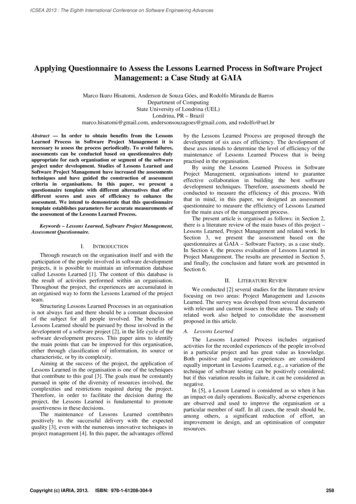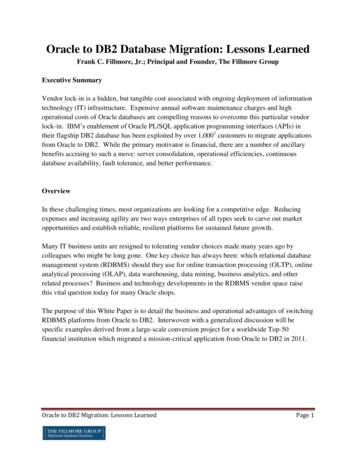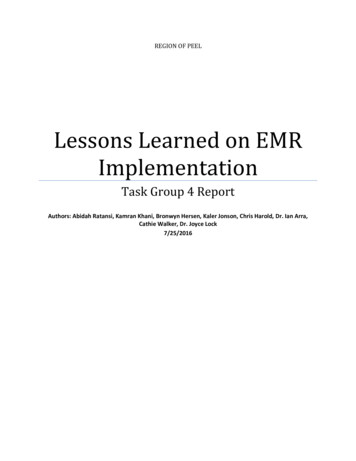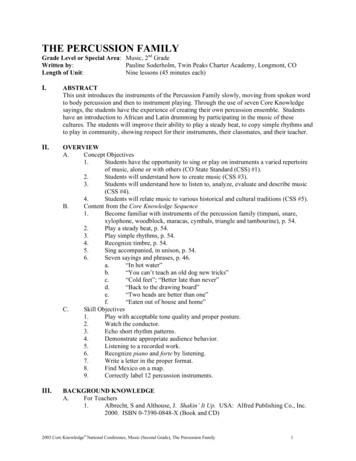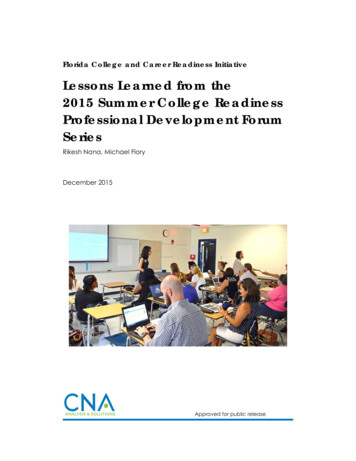
Transcription
Florida College and Career Readiness InitiativeLessons Learned from the2015 Summer College ReadinessProfessional Development ForumSeriesRikesh Nana, Michael FloryDecember 2015Approved for public release
This research was supported by the Institute of Education Sciences, U.S. Department ofEducation, through Grant R305E120010 to the CNA Corporation. The report representsthe best opinion of CNA at the time of issue and does not represent views of the Instituteor the U.S. Department of Education.Approved by:December 2015Stacey Jordan, Vice PresidentCNA EducationInstitute for Public ResearchCopyright 2015 CNA
Executive SummaryCNA Education is evaluating the Florida College and Career Readiness Initiative(FCCRI) through a grant from the U.S. Department of Education. The FCCRI is astatewide policy that has required college readiness testing in 11th grade, and thenparticipation in college readiness and success courses in 12th grade for students whodid not test as “college-ready.”Through the formative component of this evaluation (including surveys, focusgroups, and interviews during school years 2012/13 and 2013/14), CNA learnedabout several needs expressed by schools and districts with respect to improvingimplementation of the FCCRI. To meet those needs, CNA produced professionaldevelopment forums in three counties (Miami-Dade, Leon, and Duval) during summer2015. The aim was to help teachers, counselors, and administrators improvestudents’ college and career readiness, particularly those who test below collegeready on the Postsecondary Education Readiness Test (PERT).These forums may serve as a model for other districts interested in bringing togethersecondary and postsecondary educators to improve college readiness.At the forum’s conclusion, attendees were asked to provide feedback via a web-basedsurvey. A total of 155 surveys from K–12, postsecondary, and district staffrespondents were submitted.Overall, participants found all of the sessions presented at the forums to be veryuseful and relevant to their teaching and counseling responsibilities. Surveyrespondents also identified factors they believe contribute to and impede students’college readiness. They also provided their opinions about which existing andpossible new collaborations among educators could improve college readiness forstudents.Key FindingsAmong the findings from the surveys were the following: The majority of students targeted by the FCCRI need additional academicsupport in 12th grade to be ready for college-level work.i
Math teachers believe about 40 percent of their students are college-ready. English teachers believe about 50 percent of their students are college-ready. Respondents of all types believe that about 50 percent of their students havedeveloped a realistic post–high school plan.Throughout several open-ended survey questions, respondents repeatedly identifiedfactors contributing to students’ low rates of college readiness and their inability todevelop realistic post–high school plans:1.Lack of student engagement, driven by the inability of students to see a clearconnection between academic and career plans.2.Lack of student awareness of postsecondary financial aid programs.3.Lack of parental/community support in fostering a college-going culture.Regarding what forms of collaboration would be most useful in increasing theirstudents’ college readiness, survey respondents: Strongly desire to see more collaboration between high schools and statecolleges and universities, between teachers and counselors within a highschool, and between high schools and parents. Believe collaboration around college and career readiness should happenearlier, by 9th grade or even middle school.RecommendationsThe feedback provided by K–12 and postsecondary educators and district staff at theforums generated the following recommendations for the Florida Department ofEducation and other districts:1.Sponsor or co-sponsor more events that involve the interaction of collegestaff with both high school staff and students.2.Provide students with additional support in developing post–high schoolplans, such as distributing information on local high-wage and high-demandjobs.3.Work with local colleges to communicate scholarship and other financial aidopportunities to students and schools.4.Provide students with information to assist them in completing the FreeApplication for Federal Student Aid (FAFSA).5.Support districts and schools in engaging communities to encourage acollege-going culture.ii
ContentsIntroduction . viiiAbout the forums . 1About the surveys . 2Are Florida’s Students College-Ready? . 4Impediments to college readiness . 5Collaboration to Improve College Readiness . 10Existing collaborations . 11New forms of collaboration . 12Educators’ Plans for Using Forum Information . 14Recommendations. 161. Sponsor or co-sponsor more events that involve the interaction of collegestaff with both high school staff and students. . 162. Provide students with additional support in developing post–high schoolplans, such as distributing information on local high-wage and high-demandjobs. 173. Work with local colleges to communicate scholarship and other financialaid opportunities to students and schools. . 184. Provide students with information to assist them in completing the FreeApplication for Federal Student Aid (FAFSA). . 185. Support districts and schools in engaging communities to encourage acollege-going culture. . 19References . 20iii
This page intentionally left blank.iv
List of TablesTable 1.Details about the three summer 2015 FCCRI professionaldevelopment forums . 2Table 2.Distribution and average of respondents’ ratings of theimportance of impediments to their students’ college readiness . 6Table 3.Additional impediments to college readiness most commonlyreported by respondents (N 5) . 7Table 4.Distribution and average of respondents’ ratings of theimportance of various factors to increasing their students’ collegereadiness . 8Table 5.Distribution and average of respondents’ ratings of theimportance of impediments to their students developing realisticpost–high school plans . 9Table 6.Distribution and average of respondents’ ratings of the desire tosee collaboration types to improve college readiness . 10Table 7.Existing collaborations respondents had participated in betweenK-12 and postsecondary educators that improve college readinessand success . 12Table 8.New collaborations respondents believe would be most effective inimproving students’ college readiness and success . 12Table 9.Percentages of respondents who agreed or strongly agreed withstatements addressing the quality of the forums overall . 14v
This page intentionally left blank.vi
AcronymsCPSPCiti Postsecondary Success ProgramCRScollege readiness and successFAFSAFree Application for Federal Student AidFCATFlorida Comprehensive Assessment TestFCCRIFlorida College and Career Readiness InitiativeHACERHispanic Access to College Education ResourcesPDprofessional developmentPERTPostsecondary Education Readiness TestTCCTallahassee Community Collegevii
This page intentionally left blank.viii
IntroductionThe Florida College and Career Readiness Initiative (FCCRI) is a statewide policy thathas required college readiness testing in 11th grade, and then participation in collegereadiness and success (CRS) courses in 12th grade for students who did not test as“college-ready.” CNA Education is evaluating the FCCRI through a five-year grantfrom the U.S. Department of Education. The evaluation includes formative andsummative components to understand both implementation and student outcomesassociated with the initiative.As part of the formative evaluation, CNA Education conducted surveys, site visits,and interviews with district and school personnel during the 2012/13 and 2013/14school years to identify impediments to implementing the FCCRI (Mokher &Jacobson, 2014; Mokher, Jacobson, Rosenbaum, & LaLonde, 2013).This work led to collaboration between researchers and practitioners to produce aseries of professional development (PD) forums on college readiness for K–12 andpostsecondary educators across Florida in summer 2015.This memo describes that professional development forum series and new findingsfrom participant surveys about students’ college readiness conducted as part of theseries.About the forumsIn summer 2015, CNA Education held PD forums in three Florida counties (MiamiDade, Leon, and Duval) with the aim of helping teachers improve students’ collegeand career readiness, particularly for students testing below college-ready on thePostsecondary Education Readiness Test (PERT) in 11th grade.Researchers collaborated with educators in each county’s school district toindividualize the common needs identified from the ongoing FCCRI evaluation. Thisresulted in an agenda for each forum that was based on local contexts. While thetopics and activities varied across locations, sessions generally addressed collegelevel expectations for math and English courses, college-planning practices, andpathways to various careers. Partners for these events included the local schooldistricts, local Florida state colleges, and nonprofit organizations. Copies of all1
presentations and handouts from the forums can be downloaded from the FCCRIEdmodo site.1 See Table 1 for more details about each forum.The forums in Miami-Dade and Leon were each half a day in length, while the Duvalforum was part of a larger PD event hosted by the school district. Presenters at theforums included community college staff and instructors, state personnel, andresearchers. All three districts provided teachers with PD credit and compensationfor attending ( 100 stipends for attending in Miami and Leon; regular salary as partof a teacher in-service day in Duval).Table 1.Details about the three summer 2015 FCCRI professional deJune 8,2015 Education Fund Miami-Dade Barriers and Bridges for the Forgotten Half What Does It Mean to Be College-Ready Miami-Dade Planning for College College Readiness Asset Mapping Tallahassee Collaboration and Preparing Students forCollegeCounty PublicSchoolsLeonAugust 4,2015CommunityCollege(for English and Math)?Success FCCRI Legislative Changes Division of Florida TCC Scholarship OpportunitiesColleges Pathways to Well-Paying Careers Leon CountyPublic Schools Initial Course Progression and Skills Student Support Services at TCCDuvalAugust19, 2015 Florida StateCollege atJacksonville Duval County Math College Readiness English/Language Arts College Readiness State College OptionsPublic SchoolsAbout the surveysAt the forum’s conclusion, attendees were asked to provide feedback via a web-basedsurvey in Miami-Dade and Leon counties, or a shorter paper-and-pencil survey inDuval. The survey asked participants about their attitudes on K–12/postsecondarycollaboration and for their opinions of students’ college readiness and collegereadiness planning.To access the materials, register for a free account at www.edmodo.com. Once logged in tothe Edmodo site, follow this link to request to join the FCCRI group: https://edmo.do/j/ufvvtx.12
In total, 155 surveys were received, primarily from high school teachers, includingthose who teach math and English college readiness and success (CRS) courses. Othereducators who completed surveys included: K–8 teachers, high school counselors,and high school administrators, district administrators, and college staff.3
Are Florida’s Students CollegeReady?Students who were in 11th grade in 2011/12 were the first cohort required to take thePERT assessment if they had scored in the mid-range of performance on the FloridaComprehensive Assessment Test (FCAT) in 10th grade. Students with higher or lowerscores on the FCAT also had the option to take the PERT in most districts.About half (56 percent) of 11th graders took the PERT in math, and 39 percent tookthe PERT in reading.According to their PERT scores, only 27 percent of these students were college-readyin math and 46 percent were college-ready in reading in grade 11 (Figure 1). Thissuggests that the majority of students targeted by the FCCRI need additionalacademic support in 12th grade to be ready for college-level work. Figure 1.Florida PERT takers who met college readiness benchmarks as11th graders in 20124
Information gathered from surveys at two of the summer professional developmentforums (Miami-Dade and Leon) also indicates there is a need for improvement incollege readiness,2 in both math and reading.That is, on average, math teachers surveyed believe that about 40 percent ofstudents they worked with in the previous semester were “ready for college, orwould be college-ready when they left high school”; reading teachers surveyedbelieve this of 50 percent of their students (Figure 2).In addition, respondents of all types believe that, on average, about 50 percent of thestudents they worked with during the previous semester had realistic post–highschool plans. Figure 2.Average of teachers’ estimates of the percent of theirstudents who are college-ready when they leave high schoolImpediments to college readinessTo gain further insight into the low rates of college readiness, the surveys askedabout the barriers students face in becoming college-ready. Respondents were givena list of six potential impediments to college readiness and asked whichimpediments they believe are the most limiting in preventing students they workedDuval respondents were not asked to estimate the college readiness of their students, due totime constraints for completing the survey as part of the previously scheduled inservice.25
with from being or becoming college-ready or from developing realistic post–highschool plans (Table 2 Table 2).3On average, respondents rated a lack of student engagement as the mostimportant impediment to college readiness, followed by weak organizational andother “soft” skills, and insufficient support from parents/mentors. However, theother four—lack of time to provide guidance and counseling to students, lack of timeto ensure students master core subject matter, and overemphasis on teaching to thetest—were all rated as at least moderately important.Slightly important (2)Moderatelyimportant (3)Very important (4)Most important (5)Average ratingDistribution and average of respondents’ ratings of the importance ofimpediments to their students’ college readinessNot important (1)Table 2.0%3%23%38%36%4.06Weak organizational and other “soft”skills0%2%33%36%30%3.94Insufficient support from parents/mentors3%9%23%38%27%3.83Lack of time to provide guidance andcounseling to students8%13%21%23%34%3.78Lack of time to ensure students mastercore subject matter0%13%22%41%25%3.75Overemphasis on teaching to the test3%11%20%31%34%3.62CategoryLack of engagementNote: Respondents were asked to rate the importance of each impediment using a 5point scale ranging from Not important 1 to Most important 5.Respondents also were asked to name additional impediments not included in theoffered list. As shown in Table 3, most short-answer responses involved students’home or community and student social and emotional issues. Regarding theproblems faced in students’ home lives, many respondents stated that students lackparental support in becoming college-ready or in developing realistic post–highschool plans.Duval respondents were not asked to rate college readiness impediments, due to timeconstraints for completing the survey.36
Table 3.Additional impediments to college readiness most commonly reported byrespondents (N 5)Number ofresponses18CategoryHome/community issuesStudent motivation and other socio/emotional issues18Lack of academic preparation14Financial issues13Lack of knowledge about postsecondary plans otherthan traditional four-year degree13Lack of information about college/college planning7Several respondents also mentioned students coming from communities wherelanguages other than English are spoken primarily, parents not wanting to see theirchildren move away to college, and other cultural/community norms not supportiveof college going. Regarding student social and emotional issues, respondents listedstudent motivation as a key factor, with one respondent stating, “Some students havelost engagement in their studies and have lost the feeling of relevancy to theirfuture.”Factors important to increasing college readinessTo inform thinking about how to address the low rates of students who are collegeready, the survey asked respondents to rate factors important to increasing collegereadiness.On average, respondents rated understanding the connection between college andcareers, developing a realistic plan for college, and understanding the costs ofcollege as the three factors most important to increasing college readiness (Table4). These results match with the findings reported above, as respondents identifiedlack of student engagement as the most important impediment to students’ collegereadiness.7
Slightly important (2)Moderatelyimportant (3)Very important (4)Most important (5)Average ratingDistribution and average of respondents’ ratings of the importance ofvarious factors to increasing their students’ college readinessNot important (1)Table 4.Understanding the connection betweencollege and careers0%1%7%49%44%4.35Developing a realistic plan for college0%3%7%51%39%4.26Understanding the costs of college andhow to cover those costs with financialaid0%2%10%49%39%4.25Identifying career interests0%1%10%61%28%4.16Increasing academic skills0%3%15%50%32%4.11Understanding the full array of programsat state colleges and universities0%3%20%49%29%4.03Understanding the differences betweenrequirements for success in collegeversus high school0%2%23%53%22%3.95Increasing soft skills0%4%19%56%21%3.94Gaining exposure to colleges throughvisits and outside speakers2%4%33%46%16%3.69CategoryNote: Respondents were asked to rate the importance of each factor using a 5-pointscale ranging from Not important 1 to Most important 5.Impediments to creating realistic post–high school plansRespondents mentioned that about half of the students they worked with struggledto develop realistic post–high school plans.The surveys asked about impediments preventing the students they worked withfrom creating realistic post–high school plans. On average, respondents rated asmost important the lack of student engagement in the planning process,insufficient support from parents/mentors, and lack of integrating planning intothe high school program (Table 5).8
Slightly important (2)Moderatelyimportant (3)Very important (4)Most important (5)Average ratingDistribution and average of respondents’ ratings of the importance ofimpediments to their students developing realistic post–high school plansNot important (1)Table 5.3%8%16%38%36%3.95Insufficient support from parents/mentors2%16%17%32%33%3.79Lack of planning integrating into thehigh school program3%17%23%34%22%3.55Lack of accurate information aboutprograms available at postsecondaryinstitutions5%22%20%30%23%3.45Lack of accurate information aboutsources of financial aid8%20%25%27%20%3.31CategoryLack of student engagement in theplanning processNote: Respondents were asked to rate the importance of each impediment using a 5point scale ranging from Not important 1 to Most important 5.9
Collaboration to Improve CollegeReadinessThe task of improving students’ college readiness will require more than individualhigh school teachers working alone. Providing the information required to promoteacademic achievement, to connect high school curricula to post–high schoolplanning, and to inform students of postsecondary opportunities and financial aidresources necessitates cooperation across different roles and levels within theeducation system.It is therefore not surprising that, when the surveys asked which types ofcollaboration they would like more of, respondents agreed or strongly agreed thatevery form of collaboration the survey listed was needed.4 Respondents moststrongly agreed that they would like to see more collaboration between highschools and state colleges and universities and between teachers and counselorswithin a high school (Table 6). Respondents also agreed that they would like to seemore collaboration among teachers within a high school, between high schools andthe district, and across teachers in different high schools.Disagree (2)Neutral (3)Agree(4)Strongly Agree (5)Average ratingDistribution and average of respondents’ ratings of the desire to seecollaboration types to improve college readinessStrongly Disagree(1)Table 6.0%0%7%29%64%4.56Between high schools and stateuniversities0%0%7%35%58%4.51Between teachers and counselors witha high school0%2%9%36%53%4.40CategoryBetween high schools and statecolleges4Duval respondents were not asked any of the collaboration questions, due to time constraints.10
Strongly Disagree(1)Disagree (2)Neutral (3)Agree(4)Strongly Agree (5)Average rating0%2%13%42%44%4.27Between high schools and the district0%4%15%42%40%4.18Across teachers in different high schools0%5%16%40%38%4.11CategoryAmong teachers within a high schoolNote: Respondents were asked to rate how strongly they agreed that they would like tosee each form of collaboration using a 5-point scale ranging from Strongly disagree 1 toStrongly Agree 5.Existing collaborationsA short-answer section of the survey asked respondents to name what existingcollaborations were effective in improving students’ college readiness and success.The types of collaborations respondents most often listed were third-party collegeor career preparation programs, other college readiness PD forums, and collegevisits (Table 7).Respondents named collaborations with a variety of third-party college or careerpreparation programs including College Summit,5 GEAR UP,6 the Citi PostsecondarySuccess Program (CPSP),7 and the National Writing Project.8 Some of the collegepreparatory programs listed, such as the Hispanic Access to College EducationResources (HACER)9 and the Pantoja Scholars,10 are aimed at increasing collegereadiness among Hispanic students specifically.5College Summit: http://www.collegesummit.org6GEAR UP (at Miami-Dade College): http://www.mdc.edu/gearupCiti Postsecondary Success Program: onal Writing Project: spanic Access to College Education Resources: CER-one-page.pdf9Pantoja Scholars program: clatinostudentunion/calendar/details/3406691011
Table 7.Existing collaborations respondents had participated in between K-12 andpostsecondary educators that improve college readiness and successNumber ofresponsesCategoryThird-party college or career prep program9Other college readiness PD forums8College visits6Collaboration with local colleges4Collaboration between schools in district3Collaboration through dual enrollment with other colleges3Collaboration through other high school CollegeAssistance Program (CAP) Advisors2Other3New forms of collaborationThe surveys also asked respondents to describe what new forms of collaborationthey believed would do the most to improve students’ college readiness and success.Respondents suggested new forms of collaboration that involved local colleges, otherteachers, and parents (Table 8).Many respondents used this space to mention that they would like to seecollaboration about college readiness happen earlier than it is currently—that is,starting in 9th grade or even middle school.Table 8.New collaborations respondents believe would be most effective inimproving students’ college readiness and successNumber ofresponsesCategoryCollaboration with local colleges24Collaboration with other teachers5Collaboration with parents5Earlier collaboration5Full spectrum of collaboration of teachers, counselors,district staff and postsecondary staff3Collaboration between counselors and teachers2Of the respondents who would like to see new collaborations with local colleges,many had specific recommendations for this collaboration. Several mentioned theywould appreciate local postsecondary educators and counselors coming to discuss12
with students what is needed to succeed in college and what various post–highschool plans students can develop.Others recommended regular forums between postsecondary and high school facultyand staff to discuss college readiness skills for students. Respondents whomentioned the need for increased collaboration with parents highlighted the need tocreate a “college-going culture” within local communities.13
Educators’ Plans for Using ForumInformationIn general, feedback from Miami-Dade and Leon about the professional developmentforums overall was highly positive. In Duval, CNA presented only a subsection of thelarger forum presented in the other two sites. Therefore, Duval respondents were notasked to rate the forum overall.More than 80 percent of respondents agreed or strongly agreed that they weresatisfied with the quality of the forum they attended and that they would be likely toattend similar forums in the future (Table 9). Large percentages of respondents alsoagreed or strongly agreed that the forum was relevant to their professional duties,and they would use the information while teaching or counseling.At least 90 percent of respondents at each forum noted that they expected to sharethe information they learned with their colleagues. In addition, respondents praisedthe attended forum for its usefulness, thoroughness, and structure.Table 9.Percentages of respondents who agreed or strongly agreed withstatements addressing the quality of the forums overallDistrictMiamiDadeLeonI am satisfied with the overall quality of this forum90%93%If offered, I would be likely to attend a similar forum in thefuture82%89%The forum was relevant to my professional duties100%93%I am likely to use information from this forum in my teaching72%82%I am likely to use information from this forum in formal orinformal counseling students about college90%100%I expect to share the information I learned with mycolleagues90%100%CategoryAsked to consider the individual presentations at their forum, respondents listedhow they would use information from the presentations they found most useful.Many respondents noted plans to:14
Share postsecondary opportunities otherbaccalaureate degree programs with students Share information on the earnings potential for multiple types of collegecredentials with students Share scholarship and financial aid opportunities with students Work with school staff to develop action strategies that can be implementedto improve college and career readiness15thantraditionalfour-year
RecommendationsThe FCCRI professional development forums may serve as a model for other districtsinterested in bringing together K-12 and postsecondary educators to improvestudents’ college readiness.Overall, participants at the summer 2015 events found all of the sessions presentedat the forums to be very useful and relevant to their teaching and counselingresponsibilities. In their open-ended survey responses, participants also notednumerous specific examples of how they plan to use information acquired from thesessions that they found most useful.Participants also provided feedback on additional ways that the state, districts, andschools can improve college and career readiness for high school students. Below arefive primary recommendations generated by the K–12, postsecondary, and districtstaff who attended the forums:1. Sponsor or co-sponsor more events that involve theinteraction of college staff with both high school staffand students.Respondents consistently listed collaboration with
development forums in three counties (Miami-Dade, Leon, and Duval) during summer 2015. The aim was to help teachers, counselors, and administrators improve students' college and career readiness, particularly those who test below college-ready on the Postsecondary Education Readiness Test (PERT).






